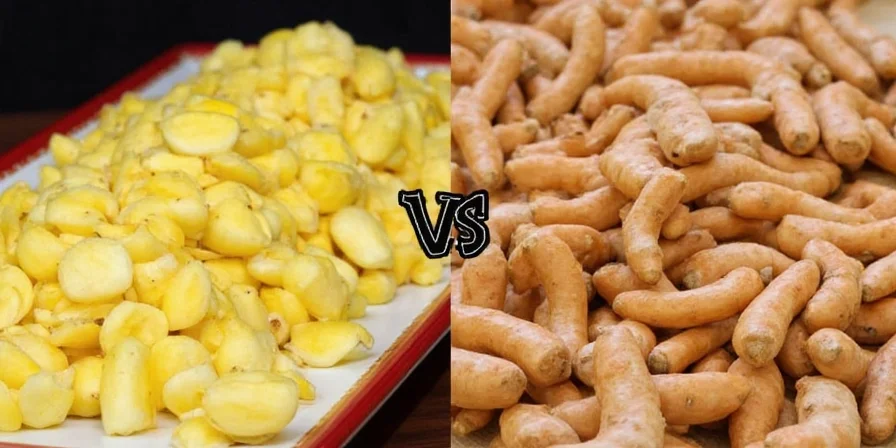Table of Contents
- Introduction
- All About Ginger
- The Lowdown on Galangal
- Head-to-Head: Ginger vs Galangal
- Pro Tips for Cooking with Ginger and Galangal
- Common Myths Busted
- Conclusion
- Frequently Asked Questions
Welcome to the Ring: Ginger vs Galangal
You’ve probably heard of ginger—it’s a kitchen staple, a flavor powerhouse, and a go-to for everything from cookies to cocktails. But what about its lesser-known cousin, galangal? It might not be gracing your latte or tea as often, but in the world of Southeast Asian cuisine, it’s a true rockstar.

In this spicy face-off, we’ll break down the differences, explore their unique flavors, and give you the tools to choose your champion like a seasoned spice warrior. No need for gloves—just grab your apron and let’s get started!
All About Ginger
Ginger (Zingiber officinale) is one of the most widely used spices globally. From Indian chai to American gingerbread, this knobby root has been warming hearts and bellies for centuries.
- Flavor Profile: Bright, zesty, peppery, and slightly sweet
- Uses: Fresh, dried, powdered, candied, pickled
- Traditional Context: Historically used in folk practices for digestive support, though not medically proven

Ginger can be found in almost any supermarket. Its versatility makes it a go-to for both sweet and savory dishes. If you've ever had a stir-fry, ginger tea, or sushi (hello, pickled ginger!), you’ve already made friends with this fiery root.
The Lowdown on Galangal
Galangal (Alpinia galanga or Kaempferia galanga depending on variety) may look similar to ginger at first glance, but that’s where the similarities end. Commonly used in Thai, Indonesian, and Malaysian cooking, galangal brings a whole new kind of heat to the table—literally and figuratively.
- Flavor Profile: Woody, piney, citrusy, and sharp—like ginger went to a punk rock concert
- Varieties: Greater galangal, lesser galangal, and sand ginger
- Uses: Fresh or dried in soups, curries, and spice pastes

Unless you frequent Asian markets or dabble in authentic Thai or Indonesian recipes, you might never have met galangal. But once you do, it’s hard to forget. It’s the secret weapon behind iconic dishes like Tom Kha Gai and rendang curry.
Head-to-Head: Ginger vs Galangal
Let’s put them side by side so you can really see—and taste—the difference. Note the cultural context: Galangal's resinous notes cut through coconut milk in Thai curries in ways ginger cannot, making substitution a flavor compromise.
| Feature | Ginger | Galangal |
|---|---|---|
| Scientific Name | Zingiber officinale | Alpinia galanga / Kaempferia galanga |
| Texture | Fibrous and juicy | Hard and woody |
| Taste | Sweet, spicy, peppery | Piney, citrusy, sharp |
| Best For | Teas, marinades, stir-fries, baking | Curries, broths, spice pastes |
| Availability | Supermarkets worldwide | Asian markets or specialty stores |

While they share a family tree (both are Zingiberaceae), they’re distant cousins with divergent culinary paths—ginger went mainstream while galangal mastered niche Southeast Asian masterpieces.
Pro Tips for Cooking with Ginger and Galangal
Cooking with these roots doesn’t have to be intimidating. Here are some pro tips to help you maximize flavor:
For Ginger
- Slicing Thin: Use a spoon to scrape off the skin—it’s easier than peeling with a knife.
- Storing: Wrap fresh ginger in plastic and freeze. Grate straight from frozen!
- Substituting: Ground ginger works in baked goods, but avoid it where fresh bite matters.

For Galangal
- Prepping: Use a microplane or food processor—it’s too tough for standard grating.
- Dried Version: Soak in warm water before grinding for deeper flavor extraction.
- Cultural Authenticity: In Thai recipes, swapping ginger alters the dish's intended character—galangal is non-negotiable for authentic Tom Kha Gai.

Common Myths Busted
Time to set the record straight on common misconceptions:
- Myth #1: “Ginger and galangal are interchangeable.”
Truth: Absolutely not. Their flavor compounds create fundamentally different taste experiences. Substitution compromises dish authenticity. - Myth #2: “Galangal is just ‘Thai ginger.’”
Truth: This oversimplification ignores galangal's unique pine-resin notes. It’s like calling saffron “yellow turmeric”—technically colorful but missing the point. - Myth #3: “You can’t grow galangal at home.”
Truth: False! In USDA zones 8–11, it thrives with sun, warmth, and well-drained soil—ideal for tropical microclimates.

The Final Word: Ginger vs Galangal
So who wins? Neither—each excels in its domain. Ginger is your versatile kitchen ally for everyday cooking. Galangal is the specialized virtuoso for Southeast Asian authenticity. Understanding their distinct roles unlocks cultural flavor dimensions you can’t achieve with substitutions.
Now you can confidently navigate recipes, avoid common pitfalls, and create dishes that honor their unique culinary heritage. Remember: spice knowledge isn’t just about ingredients—it’s about connecting with global food traditions through intentional choices.

Frequently Asked Questions
Can I substitute ginger for galangal in Thai curry?
Not without compromising authenticity. Galangal's sharp, resinous notes cut through coconut milk in ways ginger cannot. Substitution creates a sweeter, less complex broth that misses the dish's intended character.
Is galangal safe for pregnant individuals?
Galangal is commonly used in culinary amounts in traditional Southeast Asian cooking during pregnancy. However, consult your healthcare provider for personalized advice regarding dietary choices.
Where can I buy fresh galangal?
Look for it in Asian markets (especially Thai or Vietnamese stores), specialty grocers, or online spice retailers. Frozen sections often carry it when fresh isn't available.
How should I store fresh galangal?
Wrap tightly in plastic and refrigerate for up to 3 weeks, or freeze whole for 6 months. Freeze grated portions in ice cube trays with water for ready-to-use cooking increments.











 浙公网安备
33010002000092号
浙公网安备
33010002000092号 浙B2-20120091-4
浙B2-20120091-4